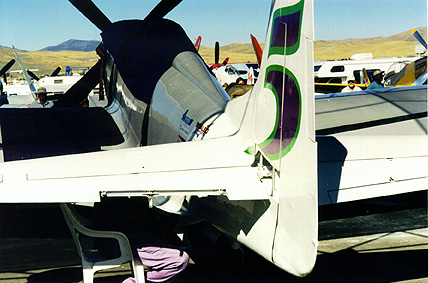Sky Captain wrote:Planes have landed safely with large parts of their wings or tail shot/broken off and control surfaces barely working.
True. However, different airplanes are constructed with different inherent stability. a P-51 was originaly a fighter plane, and those tend to have little inherent stability. A commercial airliner, on the other hand, is designed to be as stable as possible. This makes a difference when something breaks.
IIRC there was a comercial airliner that suffered engine explosion in tail that took out all hydraulic lines that powered tail control surfaces yet the pilot still managed to perform controled crash landing.
Correct, the Sioux City, IA crash, more properly known as
UA Flight 232. Some significant differences, however, are that it was a DC-10, which is inherently more stable than a P-51. While the flight control lines were severed, the control surfaces themselves where intact (more or less) and remained configured for level flight (more or less). A very rough analogy is the difference between have your car tire go flat vs. the wheel entirely departing the vehicle. In the Reno air races, though, airplanes having difficulty are told to pull up and away from the rest of the participants, which would not be straight and level flight. Another difference is that Flight 232 retained some ability to steer due to using differential engine power, but that's a property of multi-engine airplanes and a P-51 is a single engine, so no differential power capability.
Would a trim tab breaking off if other controls still work really cause such instant crash?
Yep, it certainly could. I refer you to
AA Flight 261, crashed January 31, 2000 when the jackscrew assembly for the elevator trim tab malfunctioned. The final crash took longer in part because the MD-83, again, is inherently more stable than a P-51 but also because the trim tab did not depart, it "merely" jammed. When they got it free the trim suddenly commanded a nose-dive that required two men to exert around 60 kg of force (about 140 lbs) to arrest and bring back to level flight. Keep in mind that at one point these guys were so desperate to regain control of the airplane that, finding they couldn't get it upright again,
they attempted to fly it upside-down, with intentions of attempting to land it that way as recorded on the CVR. To rephrase that, losing elevator trim can result in a situation where
attempting to land an airliner upside down seems like a reasonable course of action.
How to resolve that with records of airplanes that have had substantial portions of their tail assemblies destroyed in flight that nonetheless managed to land safely? Quite simple: not all parts of the tail assembly are equally vital. Shoot the hell out of, say, the vertical stabilizer and in many cases the fuselage provides enough such stability to allow a successful landing. There are several models of airplane that can lose up to 1/3 of their wing area and still land under control. It's not a lot of fun, mind you, but it's at least possible. Losing the elevator off the tail, though, or the rudder, or an aileron off the wing, though, and even though those parts are a relatively small part of the airplane the results are usually catastrophic.
Could a fact that during air race pilots really push the envelope contribute to cause of a crash?
Oh, sure. They're flying around 70% of the speed of sound. Keep in mind that stock mustangs in level flight went around 430 mph/700 kph. This particular one has been clocked at 550 mph/900 kph (more or less, some rounding there). The airplane was never originally designed for those higher speeds, and it's getting near the ultimate limits of prop planes utilizing fixed horizontal stabilizers/elevators.
Napoleon the Clown wrote:The planes that can pull off landing sans an entire wing are built specifically so they can do that.
Yes and no. WWII era bombers were known for getting large pieces shot off and still landing BUT a bomber is built to carry very heavy loads. So an empty bomber doesn't need all its wing area to stay aloft. Hence, when shot to hell one of the first things a bomber does it unload the “cargo” (if it hasn't already). As a P-51 isn't built to carry loads that's not an option.
Not to mention that the speeds involved when the wings suffer catastrophic damage probably would be considerably lower than what happened here.
Definitely.
Every on-line page I've found on this particular P-51 states very clearly it is
heavily modified for racing. Among the modifications listed: a much larger engine than stock (which also makes it nose-heavy and inclined to dive), reconfiguration of the canopy for less air resistance, heavier control cables for all flight surfaces because of increase aerodynamic forces, removal of five feet of wingspan for less drag and thus higher ultimate speed, larger gas tanks, stripping out all but the most basic instrumentation, removal (where possible) of all gun mounts and other military-fighter equipment (remember, this isn't a replica – it's a genuine 1944 P-51 fighter plane built and intended for combat. It might have even seen combat, I don't know).
This is a unique airplane with highly individual flight characteristics. It may or may not be more stable than a stock P-51. It also flies faster than a stock P-51, and thus is subjected to greater forces while in flight.
I was suspecting mechanical failure as the culprit here, though I was thinking more of it being a failure of the linkage to the control surfaces rather than completely losing one.
It's possible one lead to the other.
If he'd been going slower I would think such a failure wouldn't be nearly as sudden of violent, though Broomstick would probably be able to answer that with some degree of certainty.
I can't, really – as noted, this airplane is so modified as to be unique.








